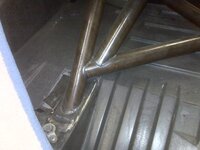i've been looking over various cage constructions and notice that additional diagonals are often tied to a main tube just above the frame mount instead of being directly connected to the frame & main tube in a compound weld. For example in the latest issue of Corvette Magazine there is a pic of the P & M GT2 chassis with this. The front frame mount is actually a short (~2") length of tube sticking up from the frame to which are welded the 4 diagonals that go the front cross bar. Why not have these diagonals meet on the frame welding pad? I guess that it makes the joint fitting and welding easier to go this way? I can also guess that some sanctioning bodies that limit roll cage contact points (NASA) may count it as '2' instead of '4' contact points. Is there a physics reason such as limiting stress at the frame or transferring the forces? I thought the ideal design was multiple triangles that meet at the vertices not near the vertices.
Steve
Steve


